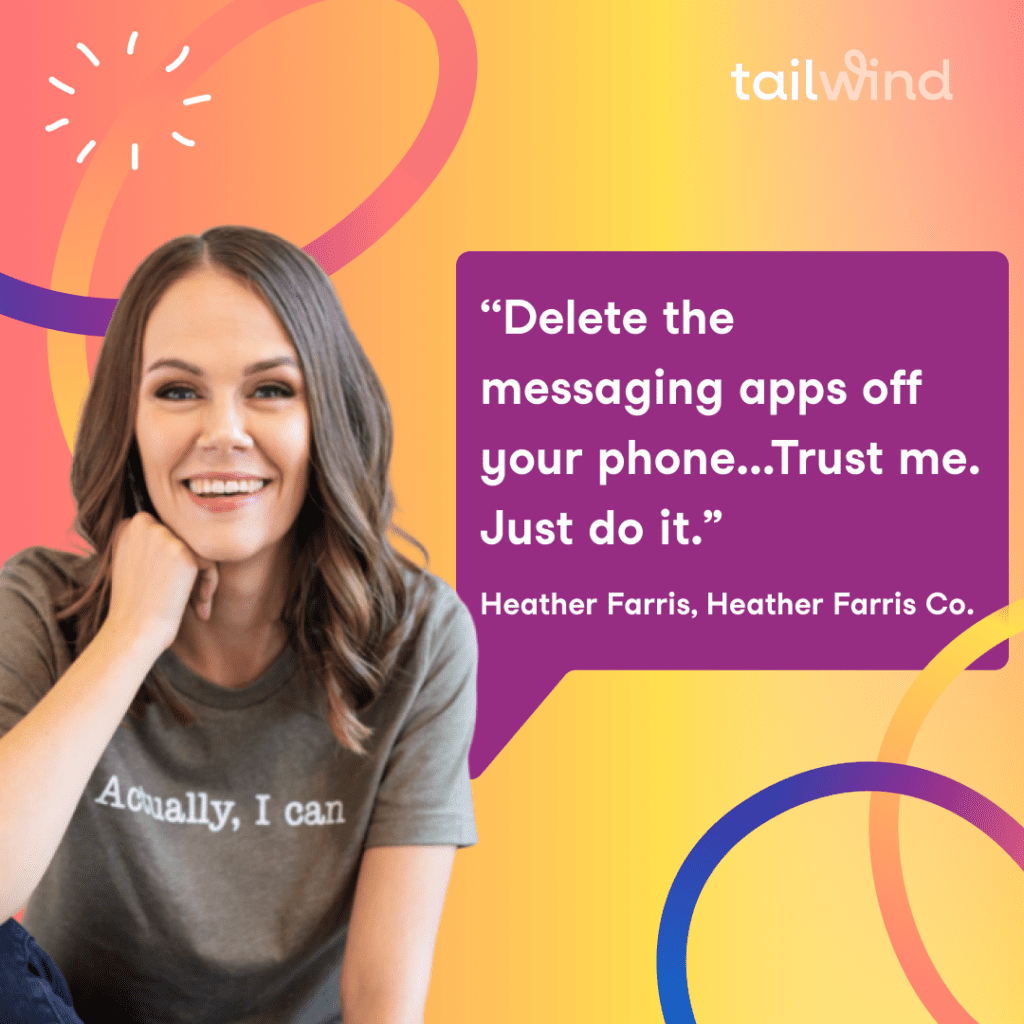
What did you give up this year because your business needed all of your time and attention?
Sleep? Time for hobbies? A vacation?
Or was it something more serious like your health or a significant relationship?
Letting your business take over all of your time and attention can make you sick, alienate you from friends and family, and crash your mental health.
The struggle to juggle responsibilities and tasks that come with small business ownership is intense!
Here are some tips from veteran business owners and entrepreneurs that we hope will help you get a better work-life balance this week, this month, and this year.
Keep reading and save this post for practical advice and strategies to help you take control of your time and become more successful and less stressed in both your business and personal life.
1. Set a timer/Take a break
The top tip from our experts was the recommendation to use a timer to establish a focused work time followed by a short break.
“My number one tip is setting a timer and only working on one thing at a time.” Kate Ahl

Kate never goes longer than 50 minutes before taking a break — other people set a shorter cycle. This strategy, similar to the Pomodoro Technique, helps improve productivity by creating a sense of urgency and promoting regular breaks to maintain concentration and prevent burnout.
We’re big fans of the Pomodoro Method! Give it a try with this online timer.
2. Match tasks to personal energy and creative cycles
People’s energy levels fluctuate throughout each day and week. Working smarter, not harder, means knowing these cycles and maximizing them for your benefit.
Typically, Mondays might bring a surge of motivation and productivity, while energy tends to dip towards the middle of the week before picking up again as the weekend approaches, influenced by the demands of managing a business and the need for periodic rest and recharge.
Kate Ahl plans her week accordingly: “Mondays tend to be the most creative, so I leverage that creative energy by only scheduling one meeting.”
What day or time of day do you feel most energized and creative? Guard that time by blocking it off on your calendar and don’t schedule meetings at that time.
Not sure when you are the most creative?
Here are a few tips to determine your personal productive rhythm.
Step 1: Document and Decode
1. Ask a trusted friend or colleague. Have they noticed the times that you seem most energized?
2. Start a mini-tracker and spend 5 minutes at the end of each day noting the times you got the most done or felt the most focused.
3. Look at your outgoing messages (emails, Slack, whatever platform you use) to deliver work. Are there patterns in the days and times you send the most finished projects?
Don’t spend more than one week on decoding.
Step 2: Create a hypothesis
Based on what you’ve learned, what do you think is your most creative time? Write it down or mark it in your calendar.
Step 3: Test
Spend a week or two using the time you think is your most creative to work on projects that demand focus and originality.
Step 4: Reflect
How did it go? Did you get more done? What adjustments should you make to your Creativity Cycle?
PRO TIP
Susan Moeller, Tailwind’s director of marketing, recommends reviewing your creative cycle periodically. “I used to be unable to get serious original work done in the late afternoon, but I’ve noticed recently that 3-5 p.m. has become more productive for me. At the same time, the early morning, which used to be my peak creative time, has felt less so. I’m realizing that my best work hours aren’t set in stone.”
3. Have a good morning routine
“Having a morning routine of spending time with yourself before interacting with the world gives you time to reflect on your day ahead and places you in a good mindset.” Niqueea Skyes

Many people find that a good morning routine sets a positive tone for the day by providing structure and prioritizing important tasks. It can lead to increased productivity, better mental and physical health, and a greater sense of overall well-being.
Don’t be intimidated thinking you need to get up two hours earlier or add more effort to your morning. Start with one small change and build from there. And, remember, good mornings often start the night before — are there any tasks you can accomplish before bed that will make your morning better?
4. Minimize distractions when you are focused on work
Most of us find this really hard to do when we constantly carry around a tool for distraction in our pockets. Yes, you know the one: our phones. And let’s not forget the constant notifications that pop up on our laptops.
Heather Farris recommends removing phone apps that keep you constantly available. “Delete the messaging apps off of your phone that your clients or students try to contact you on!” she says. “No, really, you don’t need Slack on your phone.”

Definitely set aside time to deal with those inquiries but don’t let your other work be hijacked by constant notifications.
Here are three things you can do to minimize your own phone distractions:
- Schedule specific time slots for checking your phone. This allows you to satisfy your urge for distraction without interrupting your work flow.
- Put your phone on silent mode, disable non-essential notifications, and use app restrictions or productivity apps to limit access to distracting apps and websites during work hours.
- Keep your phone out of reach while working, make it less convenient to grab your phone impulsively.
5. Cycle through work and life activities
This tip is a natural extension of using a timer for tasks. If you work at home you can switch between work and household chores for excellent work-life balance results.
Jolene Airey optimizes her productivity by managing personal tasks alongside focused work intervals, ensuring all the important work of the day is addressed without compromising deep concentration and efficiency.
Here’s how she describes her strategy:
“I start with my personal tasks like turning on the dishwasher, washing machine, and dryer. If I am making dinner, I start that at the same time, as it’s often a crock-pot meal or something that needs to thaw. I then step into my office, turn on my Cricut and embroidery machines, and set an actual timer for 27 mins to crack on with my computer work. This is my deep focus time and what works best for me. After 27 mins, I cycle through the house for 5-10 minutes to reset anything that needs doing, like the laundry. Then, it’s right back to my office to change out the Cricut and embroidery machines, followed by another 27-minute deep focus cycle.”
Learn how Tailwind Ads helped Jolene get 525% more traffic to her store, Home Stitchery Decor.
6. Set work boundaries
Small business owners often struggle to set boundaries on their work because they are deeply invested in their business. This leads to a blurred line between work and personal life and the fear that neglecting work may jeopardize the success of their venture.
However, multiple of our small business owner advisors spoke to the importance of taking breaks from their work and having clear work boundaries to maintain their well-being and to enjoy the benefits of having a small business in the first place!
“I try to work 3-4 days a week and enjoy my other days with myself, family, or friends.” -Niqueea Sykes
Heather Farris says, “I have set work hours. I will only take calls, check emails, or pop into our paid members group if I want to outside of work hours. Go one step further if you work with clients and put those non-working days, including holidays, into your contracts so you never have to defend your time off.”
Jen Vazquez sets aside, what she calls, her “designated day of delight”:

“I deliberately block my calendar on Tuesdays and immerse myself in quality time with my grandbabies. This dedicated day is a sanctuary where we play, create art, and bake up memories. To ensure uninterrupted bonding, I power down my phone, stashing it away in my purse sans notifications. This practice establishes clear boundaries and has become a trusted secret among my clients who’ve embraced it, witnessing remarkable success in their own businesses.”
Heather reminds us the importance of downtime and personal interests outside of work. “Make time for your hobbies and interests, and don’t feel pressured to monetize them. I personally love and have 30 plants and hummingbirds that I keep alive that bring me so much joy to tend to. Even if it’s something you do a few times per week or just something you do occasionally, find something and lean into it. Don’t allow your business to eclipse the life you actually want to build and forget to live it fully.”
To implement this tip make a list of 4 things that bring you joy. Block off time for them in your calendar over the next 4 weeks.
7. Automate what you can
Many tools are available to help improve productivity and work-life balance. These can be as simple as using a calendar app for blocking off time in your week for specific tasks, as already discussed. Or the tool might be very specific to your industry.
Our experts use Tailwind to create, generate, and schedule their marketing content so they can focus on other areas of their business; they use Tailwind as their marketing team.
Jolene Airey says, “The key to my work-life balance lies in intentional planning and utilizing the right tools. I use Tailwind to help write general copy for everything! It’s so easy — you type in your general concept and Tailwind goes to work in seconds generating thoughtful branded content for everything you can imagine.”

What is something in your small business that could be done by a tool instead?
PRO TIP
Knowing how much your time is worth can help you make a good decision about purchasing a new product or tool.
8. Delegate tasks
Many small business owners wear all the hats in their business, so the path to better work-life balance often involves a critical shift: learning to delegate tasks effectively.
“As a business owner, you should always be striving to free up your time, and the best way to do this is to find ways of delegating more and more of your non-strategic work to your employees. Freeing up your time for more strategic activities will indirectly help maintain your work-life balance.” Neal Schaffer
Delegating allows entrepreneurs to focus on strategic decision-making, innovation, and business growth rather than becoming overwhelmed by the day-to-day operational minutiae.

Tailwind’s co-founder and CEO Danny Maloney explains: “Often when we struggle with balance, it’s because we’re controlling too much in the business. That also takes learning opportunities away from our teams. Trust your team to take on bigger responsibilities. Then, be available as a coach to help them learn when things don’t go to plan and praise when they inevitably do it better than you could on your own.”
The amount of tasks you can off-load will depend on the size of your business, but wherever possible you should be looking to delegate your less strategic work to others.
This is also where tools can come in handy since you might not have other team members in your business but you can outsource some of your work to tools like Tailwind.
PRO TIP
We love the Eisenhower matrix to think through what can be delegated, what needs to be prioritized, and what should be simply abandoned on our to do lists.

DOWNLOAD A FREE EISENHOWER Matrix HERE
9. Team up with accountability partners
Even if you’re a solopreneur (maybe especially if you’re solo!) being accountable to other people can help you stay on task so you get your work done during your designated work hours, maintaining better work-life balance.
Niqueea Sykes has some great advice for us: “I am a part of a co-working group and we meet once a week on Zoom to just do work together. Since I work from home, this is so efficient, and it’s a great way to hold myself accountable to get work done by being surrounded by other business owners doing their work.”
Think about who you might team up with to help hold each other accountable to your work-life balance goals.
10. Take care of your physical health
Prioritizing your physical health is paramount in achieving a harmonious work-life balance, as it directly impacts your energy levels, focus, and overall well-being, influencing both professional and personal spheres.
Danny Maloney shares his experience that “the times I’m most effective are when I force myself to get to bed early and develop religion about drinking water all day long. You’ll be amazed how quickly this can help you develop more energy and a better headspace.”
And don’t neglect the importance of taking time to eat!
Heather Farris has learned to “always block off a breakfast and a lunch break from work to allow myself time to rest and actually feed myself. Earlier on in my business journey, I would just skip one or both meals to work more and realized after years of doing that that my body was deprived of nutrients, and I actually worked better when I was well fed.”
Sometimes it really is the most basic things like sleep, water, and nutrition that will significantly move the needle on your productivity.
11. Focus on your why
Small business owners often struggle to balance the demands of work and life, leading to feelings of overwhelm and potential health and relationship compromises.
Neal Schaffer advises that remembering why we do what we do can help us in our quest for work-life balance.

“What has always helped me maintain balance is never forgetting why I do what I do. There is a reason why I left corporate and struck out on my own and that is to be able to be in control of my time and how I spend it with my family. It is something I wouldn’t trade for anything in the world, and remembering this helps me maintain balance by sometimes choosing NOT to do things that will disrupt my work-life balance.”
Make this the year you become more successful and less stressed in both your business and personal life by implementing the work-life balance advice and strategies from these successful small business owners and entrepreneurs.
Which one will you start with?







